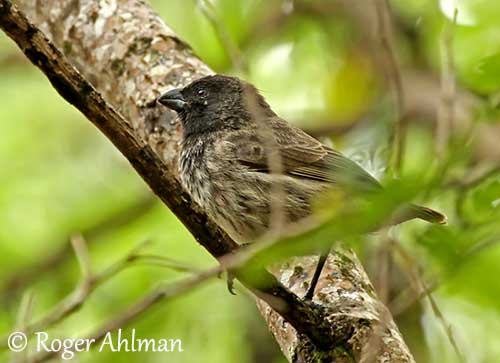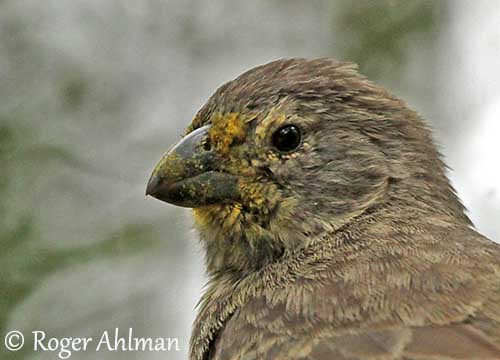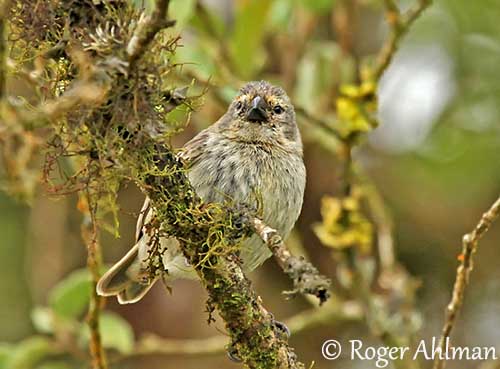
Fr: Géospize modeste
All: Kleinschnabel-Darwinfink
Esp: Pinzón de Darwin Modesto
Ita: Fringuello arboricolo di Charles
Nd: Charles' Boomvink
Sd: Mellanträdfink
Photographer:
Roger Ahlman
Pbase Galleries Peru and Ecuador
Text by Nicole Bouglouan
Sources:
HANDBOOK OF THE BIRDS OF THE WORLD Vol 16 by Josep del Hoyo- Andrew Elliot-David Christie – Lynx Edicions – ISBN: 9788496553781
BirdLife International (BirdLife International)
Wikipedia, the free encyclopaedia
Medium Tree-Finch
Camarhynchus pauper
Passeriformes Order – Thraupidae Family
Darwin’s Finches - Generalities
INTRODUCTION:
With a very small range of 23 km2 and a rapid decline, the Medium Tree-Finch is a Critically Endangered species. Only found on Floreana Island, it is vulnerable to introduced predators, diseases and habitat loss. It is endemic to Galapagos Islands and included in the Darwin’s Finches group.
DESCRIPTION OF THE BIRD:
Biometrics:
Length: 13 cm
Weight: 16 g
The adult male has blackish head forming a dark hood extending down to throat and breast.
The upperparts are brownish-olive with dark feather centres. The tail is weak and short.
The underparts are whitish to pale buffy with indistinct darker streaks on lower breast and flanks. The undertail-coverts are buffy-white and unstreaked.
The bill is intermediate between the Large Tree-Finch and the Small Tree-Finch. It is black when breeding, and dull orange with black culmen outside this period. The eyes are dark brown. Legs and feet are black.

The female is duller with greyish-brown upperparts with indistinct or absent dark feather centres. The upperwing is brownish, crossed by two narrow grey-buff wingbars. The tail is brown.
The underparts are white with weak grey streaking on breast (but variable). From belly to undertail-coverts, the plumage is pale buff and unstreaked.
The head is greyish-brown with faint paler supercilium.
The bill is dull orange with darker culmen. The eyes are dark. Legs and feet are blackish.

The immature male resembles female, but shows some hood pattern with blackish forehead, face and lower throat. It will have fully black head by five years of age.
RANGE:
The Medium Tree-Finch occurs in the highlands of Floreana, in S Galapagos Islands.
HABITAT:
The Medium Tree-Finch frequents forested habitats such as montane evergreen forest and tropical deciduous forest, and also humid scrub. It is usually found at 300-400 metres of elevation.
CALLS AND SONGS: SOUNDS BY XENO-CANTO
The Medium Tree-Finch’s calls include a high-pitched “zweee” and a nasal “phwee”.
The song consists of repeated series of notes such as “che-che-che-che-che” or “twe-twe-twe-twe”, or something different “chi’ri’ri chi’ri’ri”.
BEHAVIOUR IN THE WILD:
The Medium Tree-Finch feeds on insects, nectar, young buds and leaves. Thanks to its specialized bill, it probes in bark crevices of trees, but also searches for preys under leaves and small branches, by gleaning items from the vegetation.
The male is territorial during the breeding season, especially during the egg-laying during which it often performs mate-guarding. The pairs are usually monogamous and may have long-term pair-bonds. They maintain a small territory during the breeding season. The male sings at display nests to attract females.
The Medium Tree-Finch is resident in its range. However, it usually performs altitudinal movements after the breeding season, moving down to lower areas.

REPRODUCTION OF THIS SPECIES:
The peak of breeding occurs in February/April.
The Medium Tree-Finch usually nests in Scalesia pedunculata areas, which only remain in small patches in the highlands of Floreana Island.
The male builds the typical spherical nest with side entrance towards the top. It uses dry grasses, moss and lichens.
The female lays 4 whitish eggs with darker spots. She incubates alone during about 12 days. The chicks fledge 13-16 days after hatching.
The Medium Tree-Finch’s nests are parasitized by the accidentally introduced fly Philornis downsi, which causes large decreases in nesting success. The fly parasitism is increasing because the remaining habitat of this bird is close to cleared cultivated land with fruiting trees where adult flies are abundant.
PROTECTION / THREATS / STATUS:
The Medium Tree-Finch is uncommon and very local, and in rapid decline. Its small range of 23 km2 on Floreana Island suffers extensive habitat destruction due to agriculture expansion, alteration by invasive plant species and degradation by free-ranging domestic livestock.
Introduced predators such as pigs, cats, dogs and rats (among others) have negative effect on birds’ populations. In addition, diseases caused by avian pox (Avipox virus) infect a large proportion of birds.
Increasing tourism and disturbances involve the degradation of the favoured Scalesia habitats.
The Medium Tree-Finch is currently classified as Critically Endangered.